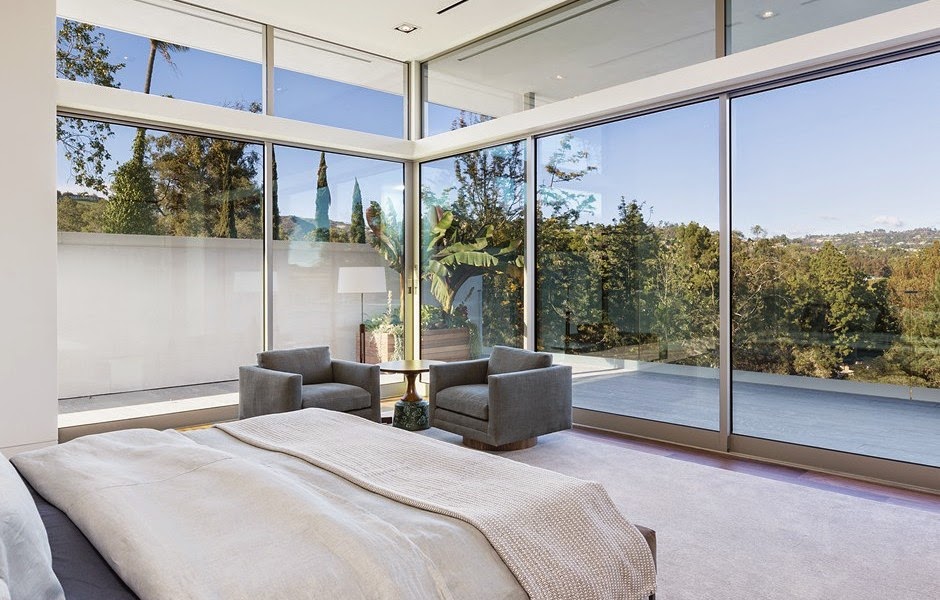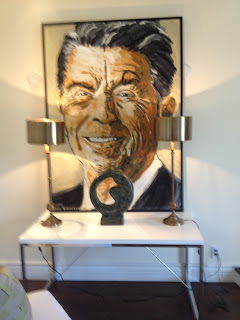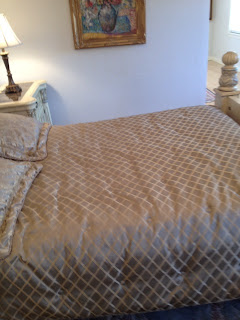In this all white fantasy land, you can meander from your white living room...
..to your white kitchen...
..to your white bedroom...
..and end the day in your white bathroom...
..where the only hints of color may be found are those prescription pills you have sitting around.
I think I'm finally tiring of it and, believe me, I'm probably as guilty as every other agent and stager in participating in the all white fantasy, as evidenced by the all white Beverly Hills home I sold a couple of months ago....
Trust me-at no point did I say to my client, "Hey, don't buy this; it's all white." I liked it as much as he did. Of course, for him it's a third home, so it will rarely have kids and pets running through it which are generally the death of the all white fantasy. I know as well as anyone that we are (partially) in the business of selling fantasy or, more kindly phrased, idealized reality. But how has this become our new fantasy, because clearly it has. What is it in our collective subconscious that this is a response to?
To use a different arena for a moment to investigate how our collective subconscious often rules our choices, let's look at network television. In the 1970's, when many of our cities were being strangled by crime and drugs and we were in the midst of sorting through huge sociological changes, our hour-television shows were about a bunch of white guys (or the occasional gal) who within an hour would track down a lot of white-collar criminals and make sure they got their due.
In the 80's, thanks to an upturn in the economy and a President who was basically telling us, "It's every man for himself," our television centered on the rich and how they could turn on each other. Today's television tells us, within that same hour, that no matter what the problem is, be it crime, disease or brutality, we have the scientific means of breaking it down and solving it, hence the rampant rise of procedural shows filling the networks. In other words, technology can cure all. I'm sure that the popularity of all of these shows through the years has been a response to our subconscious fears.
After a lot of consideration, not to mention a lot of white walls, furniture, marble and tile, I've come to believe that our current all-white decor fantasies are an instinctive reaction to the economic meltdown of 2008. When buyers could begin to trust that the sky was not going to fall (and aided by a price drop of roughly 20%), there was one factor common amongst virtually all of them: if they were going to buy something, it had to be perfect. Amongst those who did venture out to buy at this point, we all took note that the days of "wrecks" and "fixers" seemed to be totally gone. The economic meltdown so shook almost everyone's basic fears to the point where we couldn't not wonder if the insane prices buyers had been paying for apartments and houses were also delusions.
As brokers and sellers began to wise up to the market that existed, a big movement to make silk purses from sow's ears rapidly grew. Staging suddenly became a profession and a fairly lucrative one. In the strain for perfection, stagers (followed by contractors) decided the pinnacle of perfection was attained by bleaching out all imperfections and almost all color, down to wrapping books in white paper jackets (this was the first tip-off that rational thought was being thrown out the window along with those old sofas).
At first, we were all wowed by these All White Wonderlands and many still are. I, on the other hand, have grown quite weary of it. While I have engaged stagers for any number of listings, I still aim for a look that somehow signifies that someone actually lives there. Yes, I will go along with the fantasy of perfect visual order and neatness probably because those are my personal fantasies. I know it's so unlikely to happen but, hey, a guy can dream. Meanwhile, I've started to pine for listings that have "potential". I know that this craving is much more likely to be satisfied when I'm working in New York, as last week proved to me.
As I went out last week to see a string of huge, superb Central Park West apartments, it was clear that, at least amongst these owners, an attitude has returned, an attitude that states, "Hey, this is the apartment-take it or leave it." My favorite of these New Attitude apartments was at The St. Urban at 285 Central Park West, a 1902 building I have always loved for its detail and gracious, spacious layouts.
Apartment 6S faces Central Park, fronting the park for 60 feet that includes the Living Room, Dining Room, Library and Master Bedroom. It is an 11 room apartment, over 3,000 square feet, asking $7,500,000. It is a truly great New York apartment and no one here seemed to feel the slightest need to add any illusion. Or clean up...
Nice, huh? No stager here, that's for sure. And come on....
..who doesn't go for really old, blue shag carpet? And if cooking is your thing and you dream of sleek new cook's kitchen...
...you might have some work to do here. But no apologies here, anywhere. My personal favorite was one of the back bathrooms, where....
..Evan has clearly staked his claim. Evan may be a grandchild who's camped out in the apartment while he, unwisely, attends a local acting school. Or, the towel is the only thing he has selected to hold onto from Grandma's estate, which, given the previous pictures, might be a sensible choice.
Yet walking through this apartment, I was thrilled- thrilled by its possibilities, thrilled by it's layout...
..and thrilled by the fact that it wasn't all white. Perhaps it also reminded me of when I started in this business, 31 years ago, and half the apartments we showed looked like this. Our buyers were just as anxious to see them as we were.The truth is that styles in decor come and go and when you've been in this business long enough, you can walk into a house or apartment and pinpoint the last time it was updated. I remember, years ago, walking into an estate apartment on Riverside Drive and saying to my colleague, "Oh, I think we've just stepped into 1967." Sure enough, sitting on the coffee table was a copy of House and Garden from 1967 with a picture spread of the exact apartment. (Of course many of us would now kill for the Danish mid-century furniture that filled the apartment). I'm quite sure that in the not to distant future, we'll be walking into resales of all white extravaganzas and muttering, "Oh, it's so 2010."
The fact is that most of the Central Park West apartments I looked at that day, ranging in price from $5,500,000 to $23,000,000 were in this kind of condition. Okay, maybe not quite as distressed as this one but, in the end, they all needed the same amount of work. The pricing on some of these may indeed be bloated at the moment because of a misunderstanding by sellers who read the astonishing prices new construction condominiums are selling for and feel their homes should be financially on par with those. They've ignored the fact that the others are condominiums, with almost no financial restrictions for buyers, while these are all in highly selective co-ops, buildings that are looking for owners whom they know will be able to maintain their payments even in the worst of circumstances.
Personally, I would never hesitate to take a qualified buyer to see any of these, knowing that they will ultimately sell at their market value and, with work put into restoring them, they will be among the most valuable properties in Manhattan.
Most of all, I'm hoping that maybe the market will start to bend in this direction again, in Los Angeles as well, so that I won't go snow blind and can ditch the dark glasses.
Jamie Foreman
james4man@gmail.com
PS: Here's what the apartments in the St. Urban can look like when they are restored:


















































